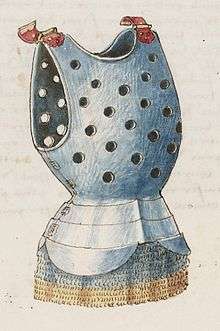Coat of plates

A coat of plates is a form of segmented torso armour consisting of overlapping metal plates riveted inside a cloth or leather garment. The coat saw its introduction in Europe among the warring elite in the late 12th or early 13th century and was well established by the middle of the 13th century. The Coate of Plates is considered part of the era of transitional armour, and by the turn of the 14th century it started to be supplanted by plate armour. The coat of plates was normally worn as part of a full knightly harness.
Construction
The plates number anywhere from eight or ten to the hundreds depending on their size. The plates overlap, usually enough to guarantee full coverage even when moving around and fighting. The coat of plates is similar to several other armours such as lamellar, scale and brigandine. Unlike scale armour which has plates on the outside or splint armour in which plates can be inside or outside, a coat of plates has the plates on the inside of the foundation garment. It is generally distinguished from a brigandine by having larger plates, though there may be no distinction in some examples.
In his 2013 PhD thesis, Mathias Goll suggests that this kind of armour made from several segments held together via leather or fabric only should be described as “segmented-armour”, in this case in the subtype "torso-front-and-back-segmented".[1]
Goll suggest a later dating of the saint Maurice statue in Magdebourg, possibly moving its production from the second half of the 13th century to the first half of the 14th century. He interprets the backplates of his coat of arms as vertically arranged lames held in place beneath leather or fabric by horisontal rows of rivets, like on some of the Wisby plates.[2]
Visby armour
One of the best resources about coats of plates are the mass graves from the Battle of Visby. The Visby coats of plates display between 8 and some 600 separate plates fastened to their backings.[3] The mass grave from a battle in 1361 has yielded a tremendous number of intact armour finds including 24 distinct patterns of coat of plates style armour. Many of these were older styles similar to the armoured surcoat discussed below.
Development
The early coat of plates is often seen with trailing cloth in front and back, such as seen on the 1250 St. Maurice coat.[4] These has been described as metal plates riveted to the inside of a surcoat. There is debate regarding whether the plates inside the armoured surcoat overlapped; but the armour is otherwise similar.
This type of armour is also documented in Norse written sources from around 1250: the Konungs skuggsjá calls it a Briost Bjorg and specifies that is should cover the area between the nipples and the belt, and the later Hirdskraa of the 1270s calls it a Plata. The former source informs us that the armour should be worn beneath the hauberk, which can explain why this form of armour so seldom appears in illustrations and statuary before the late 13th century.
In the transitional period segmented armour like the coate of plates was replaced by larger, better shaped and fitted plates. Mathias Goll stresses that while plate armour was more effective, the segmented armour could be "lighter and more flexible while it left less "dangerous" chinks". The segmented armour also put fewer demands on the craftsman, less tools and less skills. As a consequence, the "older" types could remain in production alongside more "modern" developments. Fashionable considerations played its part alongside questions of wearing comfort and levels of protection.[5]
After being replaced by plate armour among the elite, similar garments can still be found in the 15th century, as the brigandine. Another similar but later garment was the coat or Jack of plate which remained in use until the end of the 16th century.
See also
Notes
- ↑ Goll, Matthias 2013, Iron Documents Interdisciplinary studies on the technology of late medieval European plate armour production between 1350 and 1500, PhD Heidelberg, p. 42.
- ↑ Goll 2013: 69.
- ↑ Thordeman, Armour from the Battle of Wisby, 1361, 211
- ↑ Counts, David, "Examination of St. Maurice Coat of Plates", Aradour, visited Mars 22nd 2016
- ↑ Goll 2013: 53.
References
- Edge, David; John Miles Paddock (1993) [1988]. Arms & Armor of the Medieval Knight (Crescent Books reprint ed.). New York: Crescent Books. ISBN 0-517-10319-2.
- Thordeman, Bengt (2001) [1939]. Armour from the Battle of Wisby, 1361 (The Chivalry Bookshelf reprint ed.). The Chivalry Bookshelf. ISBN 1-891448-05-6.
- Counts, David. "Examination of St. Maurice Coat of Plates", The Arador Armour Library, retrieved 3/22/07
- Edge and Paddock. Arms and Armour of the Medieval Knight. Saturn Books, London, 1996.
